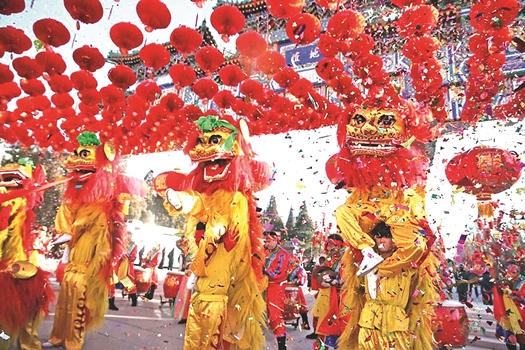Spring Festival A Chinese New Year

Dr. Harish Chandra Shah
Nepal and China are very close friendly neighbors. Like in Nepal, various traditional festivals are celebrated and observed in China. Maybe some of us have less knowledge about the Chinese festival and customs. Here, I would like to give a brief introduction about Chinese Spring Festival and New Year.
In China, and in the whole world where Chinese people live, each year when winter approaches to its end and spring season is around corner, the people throughout enthusiastically celebrate the first important traditional holiday of the year. Chinese people celebrate the spring festival as arrival of the New Year based on the lunar calendar.
This year’s New Year started from 25th January 2020. According to the Chinese lunar calendar, there are 12 animals such as mouse, ox, tiger, rabbit, dragon, snake, horse, sheep, monkey, rooster, dog, pig that symbolises the year in which a person is born. This New Year, for the Chinese people, is the year of mouse.
The Spring Festival is China's major traditional festival. Apart from the Spring Festival, the Lantern Festival, Pure Brightness Day, the Dragon Boat Festival, the Mid-autumn Festival, and Double Ninth Festival are other festivals that are celebrated as major traditional festivals with full of joy and happiness.
On the occasion of Spring Festival, the Chinese people observe one week of national holidays starting from the first day of the New Year. On the first day of the holiday, the Chinese people put on new clothes to visit relatives and friends and exchange greetings. On the second day, friends and relatives visit each other with New Year cakes, orange crunchy candy as gifts. On the third day, people just stay at home and sweeps clean their houses.
In the past, where the Chinese people used the lunar calendar, the Spring Festival was known as the "New Year". It falls on the first day of the lunar month, the beginning of a New Year.
After 19th Century, China adopted the Gregorian calendar to distinguish the lunar New Year from the New Year by Gregorian calendar, now the lunar New Year is called the Spring Festival, which is generally celebrated in the last week of January and the mid-February.
The lunar New Year's Eve (the last evening before start of the Spring Festival) is a very important time for family reunions. The whole family members get together for a sumptuous dinner, followed by an evening of pleasant talk, games etc.
Some families celebrate, attend and take part in different cultural Programs staying up throughout night to ring in the New Year. On this occasion, some opt to tie the nuptial knot considering the day as auspicious. Some embark into long tours while some opt to watch colourful television programmes aired on the occasion.
The next morning, people express their New Year greetings and best wishes to their relatives and friends. They send and receive New Year and spring festival cards. Now most of the city dwellers send greetings through WeChat and E-mails. During the New Year and Spring Festival various traditional and modern recreational activities are enjoyed in many parts of China like lion dances, dragon lantern dances and – boat rowing and stilt-walking. Firework is played to express joy and happiness during the spring festival and other auspicious occasions too.
Fireworks playing is regarded as one China's most important custom. Since several hundred years, the uses of spring festival couplets are still very popular in China. Spring Festival couplets are hung not only on the front of gates, but also on the walls and beams and in setting rooms. Preparation for the New Year begins several days early when houses are thoroughly cleaned and new clothes purchased.
It is also traditional for every family to thoroughly clean their house, in order to sweep away any ill-fortune and to make way for incoming good luck. Another custom is the decoration of windows and doors with red paper cuts and couplets.
Popular themes among these paper-cuts and couplets include that of good fortune or happiness, wealth, and longevity. Other activities include lighting firecrackers and giving money in red paper envelopes. For the northern regions of China, dumplings are featured prominently in meals
On the New Year's Eve, all the members of families come together for joint feast on thin occasion, Jiaozi – steamed dumplings are popular among Chinese people. Jiaozi is much preferred the north, while a sticky Sweet glutinous rice pudding called Nian Gao is preferred in South of China.
Guo Nian means passing the year is common term for wishing among the Chinese people for celebrating the spring festival. The Chinese celebrate the Spring Festival like X-mas for Americans and European Christians and Dashain festival for the Hindu Nepalis.
In spite of heavy influence of the western culture, Chinese people still celebrate and observe their various customs, festivals and activities accompanying traditional feasts and celebration with enthusiasm.
(The writer is President of Nepal China Cultural and Educational Council)
Recent News

Do not make expressions casting dout on election: EC
14 Apr, 2022
CM Bhatta says may New Year 2079 BS inspire positive thinking
14 Apr, 2022
Three new cases, 44 recoveries in 24 hours
14 Apr, 2022
689 climbers of 84 teams so far acquire permits for climbing various peaks this spring season
14 Apr, 2022
How the rising cost of living crisis is impacting Nepal
14 Apr, 2022
US military confirms an interstellar meteor collided with Earth
14 Apr, 2022
Valneva Covid vaccine approved for use in UK
14 Apr, 2022
Chair Prachanda highlights need of unity among Maoist, Communist forces
14 Apr, 2022
Ranbir Kapoor and Alia Bhatt: Bollywood toasts star couple on wedding
14 Apr, 2022
President Bhandari confers decorations (Photo Feature)
14 Apr, 2022











